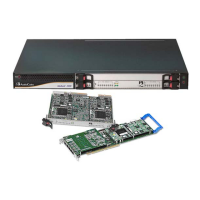Version 5.2 17 September 2007
SIP User's Manual 1. Overview
1.3 TP-1610 Overview
The TP-1610 is a complete SIP-compliant VoIP "gateway-on-a-blade", using cPCI form-
factor and based on single or dual TPM-1100 PMC modules, delivering a cost-effective
solution.
The TP-1610 is an ideal solution for SIP trunking gateways and integrated gateways for IP-
PBXs and all-in-one communication servers. The blade is designed for enterprise or carrier
applications. The TP-1610 provides up to 480 simultaneous ports for voice, fax or data for
VoIP gateway applications providing excellent voice quality and optimized packet voice
streaming over IP networks. The TP-1610 implements the award-winning, field-proven
VoIPerfect™ voice compression technology typically used in other AudioCodes products.
Employing SIP as a control protocol, the TP-1610 enables vendors and System
Integrators (SIs) short time-to-market and reliable cost-effective deployment of next-
generation networks.
The TP-1610 matches the density requirements for small to medium locations, while
meeting Network Service Providers' (NSP) demands for scalability. The TP-1610 scales
from 1 trunk span to 16 E1/T1/J1 spans (1, 2, 4, 8 or 16 E1, T1, or J1 spans) for direct
connection to PSTN / PBX telephony trunks, and includes two 10/100 Base-TX Ethernet
ports for redundant connection to the network. Thus, the blade provides an excellent
gateway solution for enterprise applications as well as carrier locations.
One or two packet processors (depending on the blade's capacity) handle packet-
streaming functions through two, redundant integral 10/100 Base-TX interfaces. Each
processor implements the industry-standard RTP/RTCP packet-streaming protocol,
advanced adaptive jitter buffer management, and T.38 fax relay over IP.
The TP-1610 supports various ISDN PRI protocols such as EuroISDN, North American
NI2, Lucent™ 4/5ESS, Nortel™ DMS100 and others. In addition, it supports different
variants of CAS protocols for E1 and T1 spans, including MFC R2, E&M immediate start,
E&M delay dial / start, loop start and ground start.
The TP-1610 enables the deployment of ‘Voice over Packet’ solutions in environments
where access is enabled to PSTN subscribers by using a trunking media gateway. This
provides the ability to transmit voice and telephony signals between a packet network and
a TDM network. Routing of the calls from the PSTN to a SIP service node (e.g., Call
Center) is performed by the TP-1610 internal routing feature or by a SIP Proxy.
Enabling accelerated design cycles with higher density and reduced costs, the TP-1610 is
an ideal building block for scalable, reliable VoIP solutions. With the TP-1610’s
comprehensive feature set, customers can quickly design a wide range of solutions for
PSTN and VoIP networks.
Note: The TP-1610 is offered as a 1-module (up to 240 channels or 8 trunk spans)
or 2-module (for 480 channels or 16 trunk spans only) platform. The latter
configuration supports two TrunkPack modules, each having its own IP
address. Configuration instructions in this document relate to the TP-1610 as
a 1-module platform and must be repeated for the second module as well.

